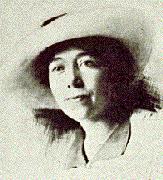
Though Minerva had little formal schooling, she was taught by her parents to read well and to appreciate good music, literature, drama, and art. She and her sister acted out plays in a willow copse on their ranch. When Minerva was four years old, her mother gave her a set of watercolors, and from that time forth, Minerva considered herself an artist. She carried sketchpad and charcoal with her constantly, sketching even the wild horses that were brought in to the corrals. After she was married, she would draw the fresh-caught fish before cooking them. Her skill in rendering life and action in animals is the expression of this early preoccupation.
When she was 14 she went to San Francisco to work as a nursemaid for a wealthy family during which time she was able to attend classes at Mark Hopkins Art School. After she returned home and graduated from Pocatello High School at age 16, she taught school, saving money to attend the Art Institute of Chicago where she studied under John Vanderpoel, a master of the academic school of painting. She returned home periodically to earn money by teaching or working in the fields so she could continue her studies. When her studies in Chicago were completed she returned to Idaho to "prove-up" her own isolated homestead, living by herself and sleeping with a revolver under her pillow. She was courted by two young men, one wealthy (who she rejected) and the other a cowboy. When she received a scholarship and left for New York City to study at the Art Student's League, she told the cowboy, Herman Teichert, to marry someone else. The League was one of the most important art centers in the world and she studied under Robert Henri and George Bridgeman, eminent realist art instructors of the time. "She paid her way by sketching cadavers for medical schools, illustrating children's books, painting portraits, and performing rope tricks and Indian dances. While in New York, she painted the mural for the waiting area in the immigrant receiving station on Ellis Island" (St. George Art Museum, 1992).
Though rated with the top artists of the time, she returned to Idaho instead of taking advantage of an opportunity to study in Europe or stepping into a professional career. She thought of Herman, and how right he was for her. Her teacher, Robert Henri, encouraged her to paint the history of the Mormon people. She returned to the west feeling she had a mission to perform.
She married Herman, kept books for the ranch, cooked for the hands, raised their five children, and painted. Her studio was their narrow living room where she tacked up her canvases to paint. The room was too small for some of her works which had to be folded as she painted. Since she could not get far enough away to get the correct perspective, she would look at her work through the wrong end of a pair of binoculars.
She painted on everything she could find: boards, aprons, the margins of books, walls and doors, and brown paper bags. She loved to paint the western wilderness with its predominance of blues and greys, but seldom by itself. Human figures and work animals, usually in a narrative were her most common subjects. She frequently used bright red to emphasize the central character. Her paintings are large and mural-like, to be viewed from a distance. The strong composition and draftsmanship combine with the delicate colors and lines and compelling narrative to produce powerful works of art. Women figure prominently in her works. Minerva also did smaller paintings of flowers, still lifes, and scenery which were usually intended for gifts.
Her best-known works are her Book of Mormon series of over 40 paintings (which can be seen at Brigham Young University) and the huge mural in the World Room of the Manti LDS temple.
Pinborough, Jan Underwood. (1989). Bold Brush. Ensign. Salt Lake City, UT: Church of Jesus Christ of Latter-day Saints. (p 34-41). St. George Art Museum Brochure. (Jan. 10 - Feb. 15, 1992). A Touch of Minerva Teichert. St. George, UT.